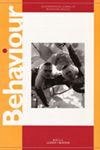Behavioural interactions between sika deer and Japanese serows: are larger and gregarious ungulates dominant?
IF 1
4区 生物学
Q4 BEHAVIORAL SCIENCES
引用次数: 0
Abstract
In ungulate assemblages, although interspecific differences in body size and gregariousness are thought to have a direct impact on winning or losing in interference competition, this has not been fully investigated. We observed a total of 64 instances of interspecific contact between larger-gregarious sika deer and smaller-solitary Japanese serows over eight years field observations. Deer-to-serow aggression were never observed. Whereas, serows showed antagonistic behaviour, such as walk push and chasing, to deer, but could rarely displace deer. Serows showed higher alertness to deer than deer did to serows. These results suggest that larger-gregarious ungulates do not necessarily exclude smaller-solitary ones and serows are sensitive to the presence of deer. Differences in aggressiveness and alertness between deer and serows may reflect differences in territoriality: serows may be more sensitive to the invasion of deer into their territory. Serows’ sensitivity to deer may have a negative effect on their population.梅花鹿和日本鹿之间的行为互动:大型群居有蹄类动物是否占主导地位?
在有蹄类动物群落中,尽管体型和群居性的种间差异被认为对干扰竞争的输赢有直接影响,但这一点尚未得到充分的研究。在8年的野外观察中,我们共观察到64例大型群居梅花鹿与小型独居的日本梅花鹿之间的种间接触。鹿对鹿的攻击从未被观察到。而雌性对鹿表现出对抗行为,如行走、推搡和追逐,但很少能取代鹿。猪对鹿的警觉性高于鹿对猪的警觉性。这些结果表明,较大的群居有蹄类动物并不一定排斥较小的独居有蹄类动物,而且服务对鹿的存在很敏感。鹿和鹿在攻击性和警觉性上的差异可能反映了领地性的差异:鹿对进入其领地的鹿的入侵可能更敏感。serws对鹿的敏感性可能会对其种群产生负面影响。
本文章由计算机程序翻译,如有差异,请以英文原文为准。
求助全文
约1分钟内获得全文
求助全文
来源期刊

Behaviour
生物-动物学
CiteScore
1.80
自引率
7.70%
发文量
44
审稿时长
3 months
期刊介绍:
Behaviour is interested in all aspects of animal (including human) behaviour, from ecology and physiology to learning, cognition, and neuroscience. Evolutionary approaches, which concern themselves with the advantages of behaviour or capacities for the organism and its reproduction, receive much attention both at a theoretical level and as it relates to specific behavior.
 求助内容:
求助内容: 应助结果提醒方式:
应助结果提醒方式:


